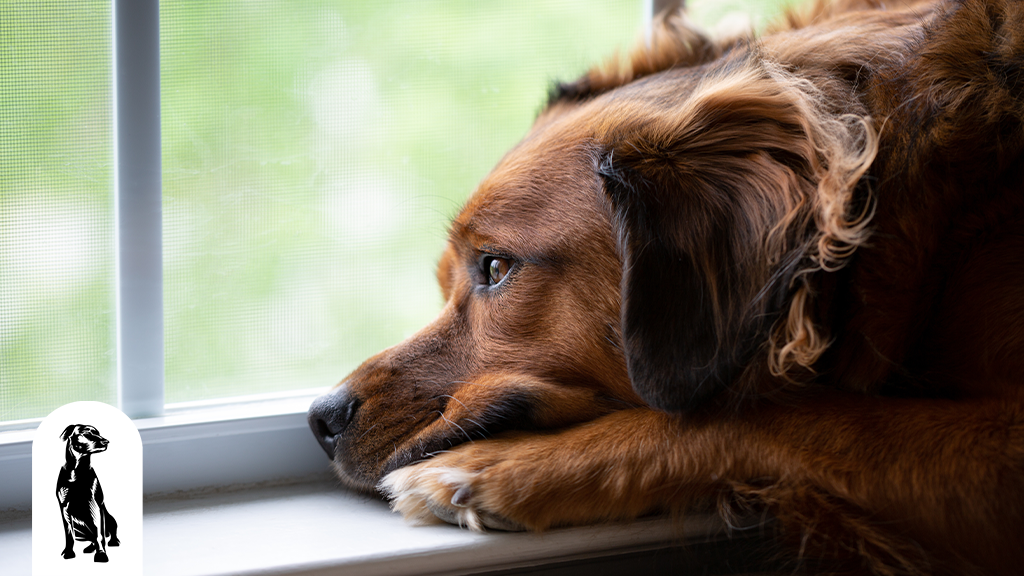
It’s cold, gray, and it’s snowing. Yep, it’s winter. And if your pup isn’t its usual cheerful self, you might wonder if dogs get SAD.
Maybe your otherwise active Goldendoodle doesn’t want to play as it did in the summer. He may sleep more, whine, and just feel down in the dumps. Sound like your pup? Learn whether dogs can get SAD (Seasonal Affective Disorder), the signs and symptoms, and what to do about it?
Dogs and Seasonal Affective Disorder
Just like humans, dogs aren’t nearly as active in winter. Recent studies have also shown that dogs likely suffer from SAD just as humans do. Veterinary Behaviorist Dr. Nickholas Dodman says it would be shocking if animals didn’t experience SAD. Scroll down to see why humans and pets can get SAD and signs to look for, as well as treatment.
Studies of SAD in Rodents
Interestingly, a few new studies on hamsters and grass rats may prove the existence of SAD in animals. The study showed that when exposed to less sunlight, the animals acted depressed, with their hippocampus having shrunk, which is a key factor in depression. Even though there are no studies yet on dogs, it makes sense they would suffer from the disorder. After all, dogs are more emotionally involved than rodents. Some vets think a pet can also mimic its owners. If you have SAD and change your behavior during the winter, they may pick up on that and do the same. Dogs are intuitive, and if they see you’re ill or sad, they may mirror that despondency. Or, they may sense that you’re upset and stay by you more often.
Why Do Pets and Dogs Get SAD?
Seasonal Affective Disorder doesn’t happen in all people nor all pets. However, the lack of sunshine, shorter daylight hours, and less access to the outdoors can directly contribute to someone developing the disorder. In the winter, humans and animals produce more melatonin (the sleep hormone), while serotonin (the feel-good hormone) decreases, so pets’ moods are likely to change. Melatonin, made in the pineal gland, regulates sleep cycles. The pineal gland is light-sensitive, which is why melatonin is typically released during the night in darkness. When light hits the retina, melatonin production reduces.
In winter, with the low light conditions, more melatonin is produced. The higher the melatonin, the more feelings of lethargy and depression will set in, along with the reduced motivation to engage in play or work. Another hormone that contributes to SAD is serotonin, which affects mood, sleep, and appetite. Low hormone levels have a distinct effect on animals and humans, thus why doctors prescribe Prozac to both. Another possible reason why dogs get SAD is simple boredom. When they’re used to going outside and rolling around in the grass, playing Frisbee with their owner, or going for long walks, suddenly having inside time can make a pup irritable.
The Sunshine Vitamin
Doctors say the “Sunshine Cure,” as it’s called for Vitamin D deficiency, is usually the cure since sunshine, or at least something that mimics the sun, has ample of the vitamin. The benefits of Vitamin D include:
- Improved brain function
- Lowered blood pressure
- Improved sleep quality
- Better bone health
- Reduction in Alzheimer’s symptoms
- Boosted growth in children
- Improved mood
- Higher serotonin levels
- Reduced cancer
- Fewer skin conditions
Even though sunshine is reduced in wintertime, getting just 10-15 minutes a day is enough to stave off SAD. Letting your dog frolic in the snow or taking it for a nice walk when it’s sunny can do wonders for its mood.
Signs of SAD in Dogs
There are several signs you can look for to see if your fur baby has winter depression. These signs include:
- Less energy
- More lethargy
- Sleeping more
- Appetite reduced
- Whimpering or whining
- Feeling sad or down
- Weight loss
- Bathroom accidents
Keep in mind, these signs can also be from medical issues, so it’s best to have your pet evaluated to ensure he’s healthy.
Dog Breeds More Prone to Depression
As mentioned above, not all dogs get SAD. Hyperactive and highly intelligent dog breeds seem to suffer more from mental illness. These breeds include Border Collie, Bichon Frise, German Shepherd, Cocker Spaniels, Basset Hounds, and Labrador Retriever. If you own one of these breeds and suffer from the above symptoms, your dog may be experiencing Seasonal Affective Disorder. Consider getting them checked out by your vet; they can recommend the best treatment.
Treatment for SAD in Pets
If your pup has the above symptoms but is otherwise healthy, you might wonder what you can do to help them. It may seem like a no-brainer, but get them out in the sun or find ways to mimic the sun. Here are some easy ways:
- When days are sunny, although cold, grab your coat and take your pup on a 10-15 minute walk.
- Take them for a joyride with the windows down.
- If you work, think about taking them to daycare to socialize with other dogs and get exercise outside.
- Place your dog’s bed under a window or a skylight.
- Purchase an artificial sunlight lamp that mimics sunlight (use for 30-45 minutes a day or as long as your vet recommends)
- Let them stay outside in a fenced yard for longer times.
- Make sure your pup is getting enough vitamin D in its diet. Check the dog food you’re serving. If your dog needs more of the vitamin, a pet multivitamin can help supplement their intake. Please note that vitamin D toxicity is possible in dogs, so only use a well-balanced multivitamin designed for dogs and ask your veterinarian for more information.
Another way to help with SAD in pets is to keep them engaged or occupied with busy activities as much as possible. Create playtime indoors by getting them fun and interactive toys. Playing with them strengthens your bond with them and vice versa and gives them the mental stimulation they need. Note that too much coddling or comforting your dog when they’re depressed may reinforce their behavior. It’s essential to keep to your daily routine and stay on schedule with feeding, bathing, etc. Also, if circumstances permit, consider getting another dog, which can help your dog’s depression.
Get Treatment for SAD
If you are struggling with SAD, we encourage you to seek out help. While vitamin D and time outside can effectively treat seasonal affective disorder for both humans and dogs, there are other therapeutic and medicinal ways with which to consider speaking with your doctor. Dogs pick up on the behaviors of their humans, so if you’re struggling, your dog may develop similar symptoms. So if you need another reason to seek out help for your mental health, do it for your furry friend!
Get Outside and Shop Plush Paws Products
Now that we know that dogs get SAD, we must do our best to bring joy and normalcy to our dogs’ lives as pup owners. Even though it’s cold outside, you can still get out with your dog and enjoy the sunshine when it’s here. Take a short road trip, go on walks, run errands together, and do all your favorite things together; just do it in a coat! And be sure to get a car seat cover so that you won’t have dog hair, melted snow, and mud all over your seats. We carry a variety of sizes, colors, and fabrics, so shop our collection today!
We ship worldwide, so all of our fellow dog lovers can experience the Plush Paws Products difference!
